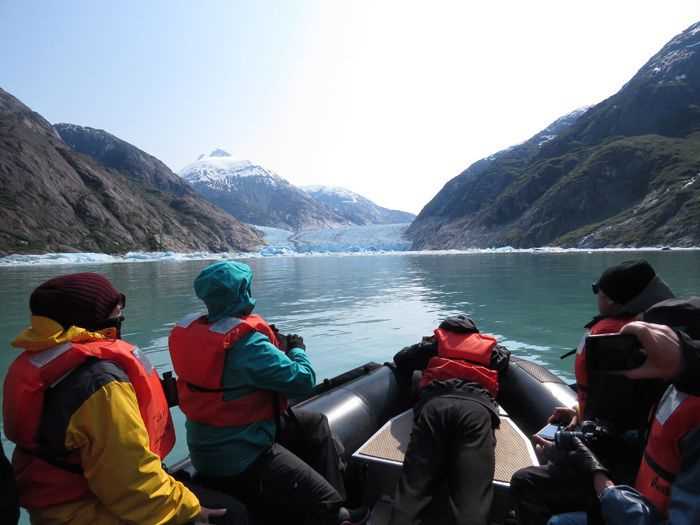We awoke this morning to sunny skies at the beginning of the 32-mile long fjord known as Endicott Arm. The steep plutonic walls of sheer rock rise up from water depths of up to 1,000 feet and reach another 3,000 feet vertically to enclose this narrow fjord. Ice that has calved from the glacier floats down and out past the terminal moraine to Stephens Passage. Endicott arm cuts into mainland Alaska, almost reaching the border of Canada. It is a fjord in a glacially carved valley, which is now flooded by the sea. At the head of Endicott Arm is Dawes Glacier. It is one of many of Alaska’s tidewater Glaciers. Tidewater glaciers drop directly into the sea.
Our first wildlife sighting was before 7 a.m. and included two humpback whales. We were able to spend the time before breakfast with them. A bald eagle perched on an iceberg as we passed. Mountain goats spotted on the upper rocks looked like clusters of snow, until seen with binoculars or a spotting scope.
When we arrived within a few miles of the Dawes Glacier, we put our Zodiac boats in the water and loaded up to explore. Arctic terns flew about and landed on the floating ice. A pair of nesting herring gulls 30 feet above the water watched our Zodiacs cruise by. This close to the glacier, the trees have given way to Sitka Alder, a low-lying shrub that is the first to grow after an area is deglaciated. Pregnant harbor seals haul out on the ice floes ready to give birth to their pups. They come here to give birth on the ice, so that the wolves and bears will not eat their newborn pups. We give them a wide berth as this is a critical time in their lives.
John Muir explored this area in the 1880’s. His Tlingit Nation guides would not go up to the glacier, because they knew that deep under the water, parts of the glacier would break off and come up as “shooters,” capsizing canoes with the large waves they create. This is submarine calving. We also do not come too close to the glacier for the same reason.
Today upon our arrival to the glacier, we find the water rife with ice. There has been catastrophic calving happening over the last few days. We find a path through the thick ice to get a bit closer to the glacier, but today it will only get within a half mile. The intense blue of the floating ice tells us that this has recently broken off the glacier.
After a long morning of exploring the ice and getting to see the wildlife, we returned to the boat. The afternoon saw no less than 14 people doing the “polar plunge” off the Zodiac boats, including the Captain and most of the staff. The end of the day was a perfect setting, as we left Endicott Arm and spent some time with two humpback whales entering the fjord.









